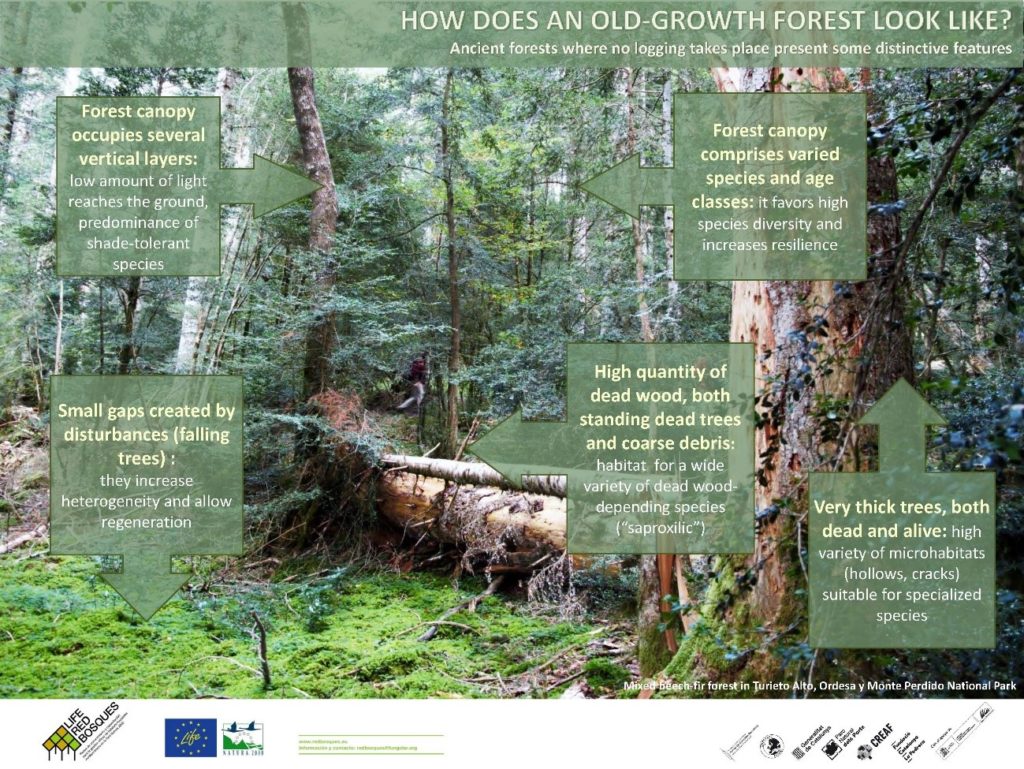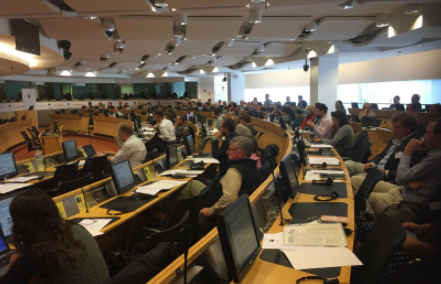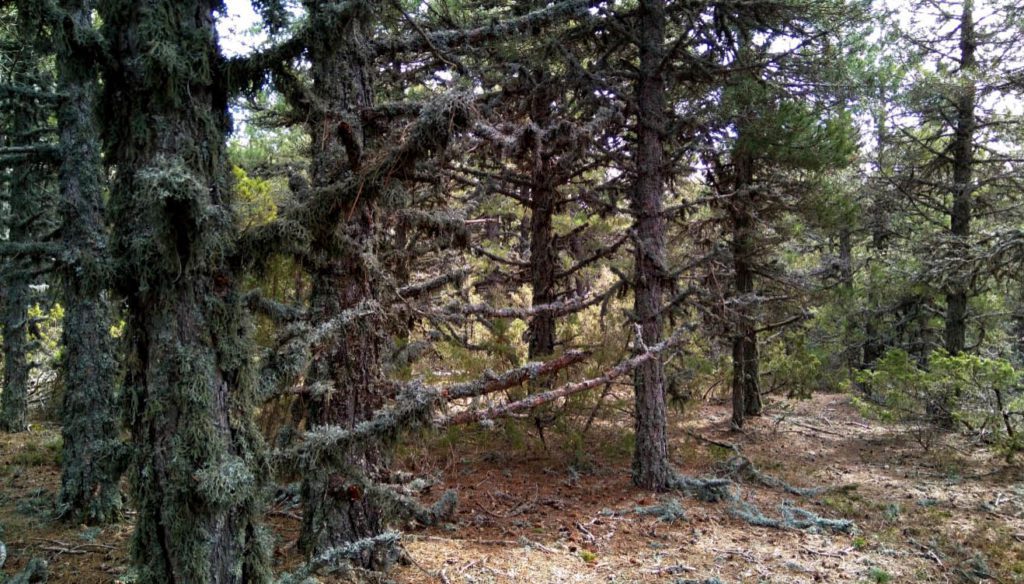Protecting old-growth forest in Europe
Montenegro, Biogradska Gora National Park © Park archive
Why discussing old-growth forest at all?
An old-growth forest is a forest that has attained great age without significant disturbance and thereby exhibits unique ecological features. In this sense, old-growth forests serve as reference for assessing the conservation status of forests and, specifically, they are used to set Favourable Reference Values for Forest Habitats identified in the Habitats Directive.
Old-growth forests are characterised by multi-layered canopies and canopy gaps, greatly varying tree heights and diameters – with diverse tree species and classes and sizes of woody debris.
This diversity of tree-related structures provide different wildlife habitats that greatly increases the biodiversity of the forested ecosystem.

What is being discussed in Brussels…
a common protection strategy for Europe?
With the major aim to discuss options for building a common protection strategy for the remaining old-growth forest (OGF) areas across Europe, Wild Europe (WE) and the EU Committee of the Regions organised the “Conference for protection of old-growth forest in Europe” on 13th and 14th September 2017 in Brussels. Being a partner of Wild Europe, EUROPARC participated in this event, alongside with representatives from various European governmental institutions and civil society voices from local to international levels.

Conference for protection of old-growth forest in Europe, Brussels, September 2017 – photo by Wild Europe
Ensuring a multi-sector approach to involving the diverse stakeholders from all relevant levels was a major priority for Wild Europe when developing an effective protection strategy: At the conference, institutions such as UNESCO, European Commission, Council of Europe, national and local governments were present as well as foresters, state agencies, enterprise specialists, landowners and conservation NGOs. All contributing actively in their roles as speakers or participants towards finding a shared strategy.
The ClientEarth lawyer network was there to advise everyone on legal and policy aspects of OGF protection and the Conservation Capital provided some specialist insight how to incentivise the private sector to engage in protection activities.
Two further highlights from EUROPARC perspective:
- Our former President Erika Stanciu led a workshop on OGF management best practice & training for protection (in her role as ProParks Foundation Director and Former State Secretary for Forests at the Romanian Ministry of Environment).
- Oscar Schwendtner from Bioma Forestal introduced examples of OGF protection initiatives at local, regional, national and international level run in Spain. As example for good networking practices at national level, Mr. Schwendtner showcased the activities of EUROPARC Spain’s “Conservation Group” and introduced EUROPARC Spain’s LIFE project on OGF in the Mediterranean – “RedBosques”.
Get an idea of RedBosques further down in this article and make sure you follow their work on the project website.
Old-Growth Forests in EU Policy – is it relevant?
Posing the question, how aware EU policy-makers are of the need for OGF protection, Daniel Calleja (European Commission-DG Environment) gave an encouraging outlook,
we are committed to restoring and protecting Old Growth Forests
Humberto Delgado (Head of Natural Capital, DG Environment) supported this statement and emphasized “the value of OGF for European climate change and ecosystem services agendas”. The main topics of the consequent debate were
- whether it made sense to advocate for a specific EU policy on OGF
- whether it might be more feasible to include it in the established EU 2020 Biodiversity Strategy
- the identification of potentials how to reinforce OGF issues within the framework of Natura 2000 related policies and the Action Plan for Nature, People and the Economy.
Old-growth and future-ready: What’s needed now?
The next steps towards a common OGF protection strategy.
Main objectives and actions were mapped out at the conference and followed up by a Wild Europe Meeting in December
- The strategic objectives should be linked to the climate change agenda and indicate the economic value of OGF protection. To raise the topic on political agendas and get the private sector on board.
- Agreeing on a shared European definition of OGF. To achieve an effective common approach towards protection and restoration.
- The definition should be practical and therefore relatively flexible to allow its adjustment to different national realities and ensure it can be implemented.
- Putting in place an instrument to locate and monitor old growth forest sites across Europe. To provide early notice of prospective threats, allowing also to discriminate between “legal” and “illegal” logging activities for example.
- Conduction of an assessment of new forms of long-term protection structures: traditional and innovative, including proposals for improving cash flow opportunities from the Payment for Ecosystem Services (PES) agenda.
- Investigation of the potential of coordination between UNESCO World Heritage and Natura 2000 networks, with the protection strategy acting as a pilot.
A comprehensive compilation of the speakers, topics and presentations from the Wild Europe conference can be accessed here. You might also want to find out some further information on the preparatory consultations for the proposed protection strategy, but most importantly: Make sure you follow the updates on the process provided here or by getting in touch with Wild Europe.
Different countries, different relevance
What’s being done across countries already?
The high number of registrations to the conference (about 150 participants from 28 EU and non-EU countries) indicates the high interest in the issue by the different countries. From Wild Europe Network, members confirm that the identification of new OGF areas and their protection was currently high on Romanian and Ukrainian political agendas (including allocation of funding). In Austria, the topic was not discussed as extensively but was nevertheless considered relevant; and in the case of Germany, OGF were considered an important argument to advocate for more national wilderness.

PN Puebla de San Miguel Spain
Country Case: Management of old-growth forests in Spain
What are the challenges at management level in Spain?
EUROPARC Spain old-growth forests are one of the central focus of RedBosques, a 3 year Life project, coordinated by EUROPARC Spain, which seeks to:
- outline baseline scenarios for assessing the conservation status of Mediterranean forests
- develop criteria and tools for the design and implementation of forestry management practices in Natura 2000 Mediterranean forests with objectives that regard biodiversity conservation and climate change adaptation
- transfer state-of- the-art knowledge to target audience and stakeholders.
In the context of the Life RedBosques project, EUROPARC Spain recently organised a three-day meeting (22-24 November 2017) in the Els Ports nature park (Tarragona), with about 40 attendees involving forest and protected areas managers, administration representatives and the private sector (landowners). Teresa Pastor, from EUROPARC Directorate, also attended.
The focus of the meeting was twofold: to share the progress of identification of old-growth forests in the different Spanish regions and to exchange on management practices to accelerate the process of maturation of those forests in a state close to old-growth.
Managment actions – if any – should:
- be directed to emulate nature
- by recreating natural events such as lightings and strong winds
- which would produce the fall down of tres and the breaking of branches
- eventually leaving wood debris on the soil.
Get some background on the RedBosques project beginnings in our article here. Follow how RedBosques project approaches its challenging objectives via EUROPARC Spain’s Twitter, Facebook and the LIFE project website – and make sure you don’t forget to share their outputs!
The project is coordinated by EUROPARC Spain (José Antonio Atauri) and Fundación Fernando González Bernáldez.